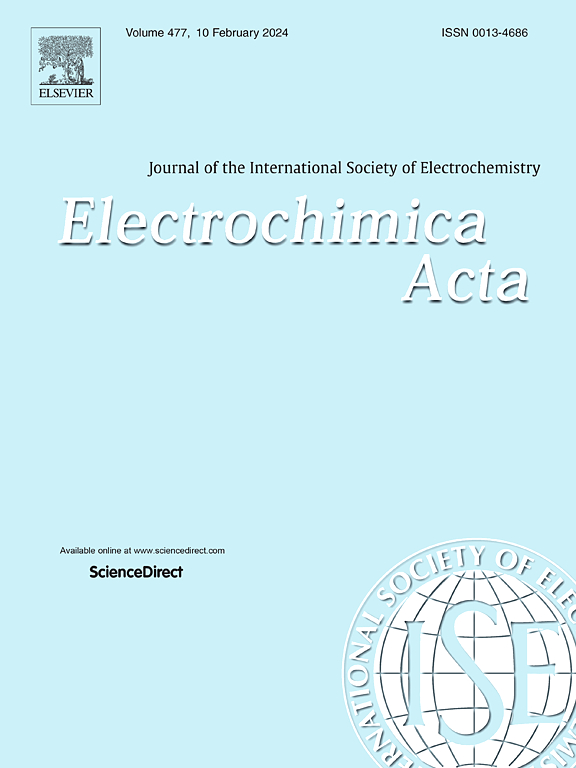New method for graphing impedance values as an analytical tool suitable for electrochemical impedance spectroscopy
IF 5.5
3区 材料科学
Q1 ELECTROCHEMISTRY
引用次数: 0
Abstract
A new method for graphing electrical impedance values named a “differentiation-based Bode plot” is proposed. This method facilitates the analysis procedure and reduces the arbitrariness of the interpretation of electrochemical impedance spectroscopy (EIS) data. Among the various methods for graphing impedance values, Nyquist plots are commonly adopted (primarily in the field of EIS) because of the apparent correlation between their shape and the corresponding equivalent circuit. However, because Nyquist plots do not contain frequency information, Bode phase and magnitude plots are frequently utilized. Although such plots are suitable for determining the absolute magnitude and phase of the impedance, they are not always useful for selecting the structure of an equivalent circuit, which is a hypothetical model for electrochemical cells. In the proposed method, instead of the real (Z’) and imaginary (Z’’) parts, two functions of the impedance derivatives with respect to frequency, i.e., dZ’/d(log f) and dZ’’/d(log f), are plotted. As substitutions for the Bode phase and magnitude plots, arctan{dZ’’/d(log f) ÷ dZ’/d(log f)} and log[sqrt{(dZ’/d(log f))2 + (dZ’’/d(log f))2}] are plotted against log f. Unlike the classical Bode plot, the differentiation-based Bode plot is independent of the lateral shift in the Nyquist plot, which is advantageous for determining an equivalent circuit. To demonstrate this advantage, the impedance values of typical equivalent circuits used in electrochemistry are calculated and plotted to compare differentiation-based Bode plots with Nyquist and classical Bode plots.
绘制阻抗值图表的新方法,作为适合电化学阻抗光谱分析的分析工具
本文提出了一种绘制电阻抗值的新方法,名为 "基于微分的 Bode plot"。这种方法简化了分析程序,减少了解释电化学阻抗光谱(EIS)数据的随意性。在绘制阻抗值的各种方法中,奈奎斯特图(主要是在 EIS 领域)被普遍采用,因为其形状与相应的等效电路之间存在明显的相关性。不过,由于奈奎斯特图不包含频率信息,因此经常使用博德相位图和幅值图。虽然这种图适合确定阻抗的绝对幅值和相位,但并不总是有助于选择等效电路的结构,而等效电路是电化学电池的假设模型。在建议的方法中,绘制的不是实部(Z')和虚部(Z''),而是阻抗相对于频率的两个导数函数,即 dZ'/d(log f) 和 dZ''/d(log f)。作为波德相位图和幅度图的替代,arctan{dZ''/d(log f) ÷ dZ'/d(log f)} 和 log[sqrt{(dZ'/d(log f))2 + (dZ''/d(log f))2}]是相对于对数 f 而绘制的。与经典波德图不同,基于微分的波德图与奈奎斯特图中的横向偏移无关,这对于确定等效电路非常有利。为了证明这一优势,我们计算并绘制了电化学中使用的典型等效电路的阻抗值,以比较基于微分的 Bode 图与奈奎斯特图和经典 Bode 图。
本文章由计算机程序翻译,如有差异,请以英文原文为准。
求助全文
约1分钟内获得全文
求助全文
来源期刊

Electrochimica Acta
工程技术-电化学
CiteScore
11.30
自引率
6.10%
发文量
1634
审稿时长
41 days
期刊介绍:
Electrochimica Acta is an international journal. It is intended for the publication of both original work and reviews in the field of electrochemistry. Electrochemistry should be interpreted to mean any of the research fields covered by the Divisions of the International Society of Electrochemistry listed below, as well as emerging scientific domains covered by ISE New Topics Committee.
 求助内容:
求助内容: 应助结果提醒方式:
应助结果提醒方式:


